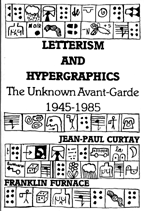References and Notes for Lettrism:
 1. A
short history of Isou's life can be found in Jean-Paul Curtay's introductory
essay for the exhibit catalog (which also contains an extensive amount of
illustrations and other rare documents), Letterism and Hypergraphics: The
Unknown Avant-Garde 1945-1985 (New York: Franklin Furnace, 1985):
Romania 1925 -- Isou's mother was pregnant with him. Isou's father happened
to have a lot of free time. He decided to make an experiment. He prepared
himself by training a dog to give the forthcoming baby an exceptional start. He
coached the "super-baby" into walking, biking, talking, reading,
writing, drawing as soon as he could and, later pumped into the boy all the
knowledge he held. A more detailed study in French of Lettrism by Curtay
can be found in his La Poesie Lettriste (Paris: Éditions Seghers,
1974).
1. A
short history of Isou's life can be found in Jean-Paul Curtay's introductory
essay for the exhibit catalog (which also contains an extensive amount of
illustrations and other rare documents), Letterism and Hypergraphics: The
Unknown Avant-Garde 1945-1985 (New York: Franklin Furnace, 1985):
Romania 1925 -- Isou's mother was pregnant with him. Isou's father happened
to have a lot of free time. He decided to make an experiment. He prepared
himself by training a dog to give the forthcoming baby an exceptional start. He
coached the "super-baby" into walking, biking, talking, reading,
writing, drawing as soon as he could and, later pumped into the boy all the
knowledge he held. A more detailed study in French of Lettrism by Curtay
can be found in his La Poesie Lettriste (Paris: Éditions Seghers,
1974).
2. Several essays examining
Lettrist art can be found in the special issue 'Lettrisme: Into the Present' of
Visible Language, Volume XVII Number 3 (Cleveland, OH: Merald E.
Wrolstad, Summer 1983).
3. 29. The origins of the spectacle
is the loss of the unity of the world, and the gigantic expansion of the modern
spectacle expresses the totality of this loss: the abstraction of all specific
labor and the general abstraction of the entirety of production are perfectly
translated in the spectacle, whose mode of being concrete is precisely
abstraction. In the spectacle, one part of the world represents itself before
the world and is superior to it. The spectacle is nothing more than the common
language of separation. What ties the spectators together is no more than an
irreversible relation at the very center which maintains their isolation. The
spectacle reunites the separate, but reunites it as separate. Guy Debord,
Society of the Spectacle (Detroit, MI: Black & Red, 1970). An
"unauthorized" translation with no copyright typical of many
Situationist publications. Ironically, Zone Book's 1995 publication of Donald
Nicholson-Smith's translation of this work, has a very restrictive copyright
which prohibits even publishing quotes from the work electronically.
4. Greil Marcus, 'Guy Debord's
Mémoires: A Situationist Primer' in On the passage of a few people
through a rather brief moment in time: THE SITUATIONIST INTERNATIONAL
1957-1972, edited by Elisabeth Sussman (Cambridge, MA: The MIT Press,
1991), p. 127. This is an exhibit catalog of essays, illustrations and artistic
documents for a retrospective held at the Pompidou Center, Institute of
Contemporary Arts in London, and The Institute of Contemporary Art in Boston
from 1989 to 1990.
5. Translated in English in
Situationist International Anthology, edited and translated by Ken Knabb
(Berkeley: the Bureau of Public Services, 1981), p. 319.
6. An account of the May '68 Strike
from the view point of the Situationists (complete with detourned comics and
graffiti), can be found in Enragés and Situationists in the
Occupation Movement, France, May '68, by René Viénet, English
translation (Brooklyn/London: Autonomedia/Rebel Press, 1992 [Paris: Editions
Gallimard, 1968]).
7. Sadie Plant, The Most Radical
Gesture: The Situationist International in a Postmodern Age (London and New
York: Routledge, 1992).
8. Greil Marcus, Lipstick Traces:
A Secret History of the 20th Century (Cambridge, MA: Harvard University
Press, 1989).
9. Stewart Home, THE ASSAULT ON
CULTURE: utopian currents from Lettrisme to Class War (London: Aporia Press
& Unpopular Books, 1988).

Last Modified 21 January 1998
 1. A
short history of Isou's life can be found in Jean-Paul Curtay's introductory
essay for the exhibit catalog (which also contains an extensive amount of
illustrations and other rare documents), Letterism and Hypergraphics: The
Unknown Avant-Garde 1945-1985 (New York: Franklin Furnace, 1985):
Romania 1925 -- Isou's mother was pregnant with him. Isou's father happened
to have a lot of free time. He decided to make an experiment. He prepared
himself by training a dog to give the forthcoming baby an exceptional start. He
coached the "super-baby" into walking, biking, talking, reading,
writing, drawing as soon as he could and, later pumped into the boy all the
knowledge he held. A more detailed study in French of Lettrism by Curtay
can be found in his La Poesie Lettriste (Paris: Éditions Seghers,
1974).
1. A
short history of Isou's life can be found in Jean-Paul Curtay's introductory
essay for the exhibit catalog (which also contains an extensive amount of
illustrations and other rare documents), Letterism and Hypergraphics: The
Unknown Avant-Garde 1945-1985 (New York: Franklin Furnace, 1985):
Romania 1925 -- Isou's mother was pregnant with him. Isou's father happened
to have a lot of free time. He decided to make an experiment. He prepared
himself by training a dog to give the forthcoming baby an exceptional start. He
coached the "super-baby" into walking, biking, talking, reading,
writing, drawing as soon as he could and, later pumped into the boy all the
knowledge he held. A more detailed study in French of Lettrism by Curtay
can be found in his La Poesie Lettriste (Paris: Éditions Seghers,
1974).